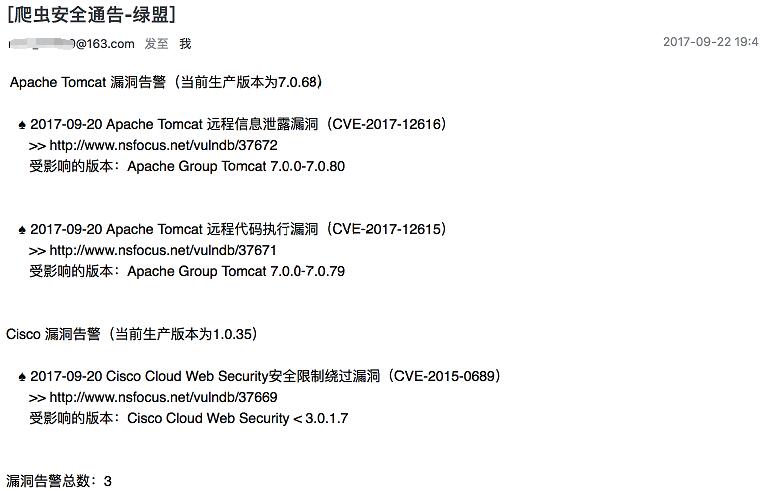优化中...
#! /usr/bin/env python
# -*- coding:utf-8 -*-
# Author: Tdcqma
'''
v17.0920.1401 基本功能实现,漏洞标题与漏洞链接优化
v17.0922.1800 已实现对【Cisco 漏洞告警】提供受影响的版本信息
v17.0922.1913 优化代码,对版本v17.0922.1800实现函数化
'''
import urllib.request
import ssl,re
import smtplib,email
import datetime
f = open("secInfo-lvmeng.txt", 'w', encoding='utf-8')
#today = str(datetime.date.today()) # 指定以当前时间为搜索条件
today = "2017-09-20" # 临时指定测试时间
# 生产列表保存所有安全漏洞标题
tomcat_sec = ["Apache Tomcat 漏洞告警(当前生产版本为7.0.68)
"]
Cisco_sec = ["Cisco 漏洞告警(当前生产版本为1.0.35)
"]
WebLogic_sec = ["WebLogic 漏洞告警(当前生产版本为10.33)
"]
Microsoft_sec = ["Microsoft 漏洞告警(当前生产版本为windows2012)
"]
Noinfo_sec = "本日无爬虫安全告警.
"
tomcat_msg = ''' '''
WebLogic_msg = ''' '''
Cisco_msg = ''' '''
Microsoft_msg = ''' '''
count = 0 # 计算告警漏洞总数
str_domain = "http://www.nsfocus.net"
msg_fl = ""
newline = ""
def get_infected_vision(info_sec,info_msg,sub_url):
line = " ♠ " + today + " " + title + "
>> " + sub_url + '
'
info_msg += line # 逐行读取,将其保存到msg字符变量里。
info_sec.append(line)
global count
count += 1
# 进入漏洞详细页面,调取受影响的漏洞版本
vul_request = urllib.request.Request(sub_url)
vul_response = urllib.request.urlopen(vul_request)
vul_data = vul_response.read().decode('utf-8')
# 正则表达式匹配受影响的版本
affected_version = re.findall("<blockquote>.*</blockquote>", vul_data, re.S)
affected_version = " 受影响的版本:" + affected_version[0][12:-13], '
'
for newline in affected_version:
newline = newline.replace('<', '<')
info_sec.append(newline + '
')
for i in range(5): #指定被扫描网站需要扫描的网页数范围,默认读取1-10页,即一天的漏洞个数可能要占用好几个页面
url = "http://www.nsfocus.net/index.php?act=sec_bug&type_id=&os=&keyword=&page=%s" % (i+1)
request = urllib.request.Request(url)
# 当尝试访问https开始当站点时,设置全局取消SSL证书验证
ssl._create_default_https_context = ssl._create_unverified_context
response = urllib.request.urlopen(request)
data = response.read().decode('utf-8')
if today in data:
# 用于匹配内容的正则表达式部分
str_re = "<.*" + today + ".*"
res = re.findall(str_re, data)
for line in res:
title_craw = re.findall("/vulndb/d+.*</a>", line) # 获取标题
title = title_craw[0][15:-4]
url_craw = re.findall("/vulndb/d+", line) # 获取链接
sub_url = str_domain + url_craw[0]
if "Apache Tomcat" in title:
get_infected_vision(tomcat_sec,tomcat_msg,sub_url)
elif "WebLogic" in title:
get_infected_vision(WebLogic_sec,WebLogic_msg,sub_url)
elif "Cisco" in title:
get_infected_vision(Cisco_sec,Cisco_msg,sub_url) # 获取漏洞的受影响版本
elif "Microsoft" in title:
get_infected_vision(Microsoft_sec,Microsoft_msg,sub_url)
msg_fl = [tomcat_sec, WebLogic_sec, Cisco_sec,Microsoft_sec]
secu_msg = ''' '''
for i in range(len(msg_fl)):
if len(msg_fl[i]) > 1:
for j in range(len(msg_fl[i])):
secu_msg += msg_fl[i][j]
msg_fl = secu_msg
if count == 0 :
msg_fl += Noinfo_sec
msg_fl += ("漏洞告警总数:" + str(count))
else:
msg_fl += ("漏洞告警总数:" + str(count))
f.writelines(msg_fl)
f.close()
# print(msg_fl)
# 发送邮件
chst = email.charset.Charset(input_charset = 'utf-8')
header = ("From: %s
To: %s
Subject: %s
" %
("from_mail@163.com",
"to_mail@163.com",
chst.header_encode("[爬虫安全通告-绿盟]")))
# 借用163smtp服务器发送邮件,将上面读到的报警信息作为邮件正文发送。
email_con = header.encode('utf-8') + msg_fl.encode('utf-8')
smtp = smtplib.SMTP("smtp.163.com")
smtp.login("from_mail@163.com","from_mail_password")
smtp.sendmail('from_mail@163.com','to_mail@163.com',email_con)
print('mail send success!')
smtp.quit()
爬虫邮件告警截图:
